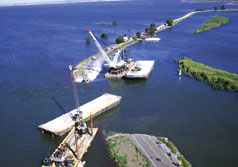 |
| Pests. Failure of delta agricultural levee in 2004 may have been caused by burrowing critters. It flooded 12,000 acres and caused $100 million of damage. (Photo courtesy of California Department of Water Resources) |
Built to channel the Sacramento, Cosumnes, Mokelumne and San Joaquin rivers and the lacy Delta region where they converge en route to San Francisco Bay, the levees bring flood protection to a vast swath of fertile farmland and urban areas, including Sacramento. They also funnel 7.5 million-acre-feet of water to drinking water transmission pumps in Tracy.  click here to view map
click here to view map
But the aging earthen levee system offers marginal protection at best. Construction began in the mid-1800s and much of it rests on organic loam or a deep layer of sand. The dikes are susceptible to seepage that can lead to blowouts in extreme flooding events.
In the Delta, many of the levees are privately-owned, sunken islands built to the Federal Emergency Management Agencys "agricultural" standards. They have minimum levee crown widths of 16 ft, waterside slopes of at least 1.5 horizontal to 1 vertical, landside slopes of at least 2:1 and levee freeboard of 1.5 ft above the average 100-year flood. Failure of such a levee west of Stockton in 2004possibly due to animal burrowingflooded 12,000 acres of farmland. The event caused $100 million of damage (ENR 7/12/2004 p. 7).
Engineers say the options for improvements and paying for them are as varied as the politicians, engineers and geography of the system. But improvements are being made. Last February, after 15 years of work to raise levees, insert slurry walls and build pumping facilities, Sacramentos 107 miles of urban levees were declared in compliance with FEMAs 100-year urban flood protection standard. Freeboard is 3 ft above the base flood level, waterside slopes are 2:1 and there is at least a 15-ft crown.
Thats the good news. The bad news is that some of those levees are underseeping. Raising them to a 200-year standard would require building 80-ft-deep seepage berms and closing gaps in slurry walls at a cost of $200 million, according to the Corps initial estimate. Stein Buer, the Sacramento Area Flood Control Agencys executive director, says he hopes the Levee Seepage Task Force "will find a way to do the work for less."
In the meantime, several projects are planned. Chris Neudeck, principal at consulting engineers Kjeldsen, Sinnock, Neudeck Inc., Stockton, says levee work in Sacramento and the Delta can range from "treating a superficial wound to heart surgery," depending on the problems severity and the money available.
 |
| Land Plan. Developers scheme to create new levee-ringed town is drawing fire. (Photo courtesy of River Islands) |
The least expensive fix ($1 million per mile or less) often consists of adding a plastic sheet and a 200-foot-wide berm halfway up the landside of the levee. This counteracts the weight of the water on the other side and increases the distance subterranean seepage must travel. Local materials work even on porous, loamy foundationsif the material is applied slowly and the load is spread widely, Neudeck says. The method is not an option, however, when development has reached the toe of the levee.
Seepage barriers are another option. They do not broaden the levee and vary in size, style and cost, says Ray Costa Jr., principal engineer for geotechnical services at Kleinfelder Inc., San Diego.
Costa says contractors working for SAFCA started building seepage barriers by using backhoes to trench to levee depthabout 30 ftand insert a wall of bentonite clay. When seepage was discovered, deep soil mixing augers were brought in to reach a non-porous clay layer as deep as 150 ft.
Seepage barriers cost $3 million to $4 million per mile, depending on the depth of the barrier and access. R. Kevin Tillis, a principal engineer at Concord, Calif.-based Hultgren-Tillis Engineers, calls bentonite barriers "a temporary fix" that can break down over time.
A similar solution, but more difficult and costly ($4 million to $6 million per mile), is sheet-pile insertion. "This has to be done where there arent homeowners to complain about plates falling off shelves," says Neudeck.
Setback or attached-setback levees are more controversial. A second levee is built 500 to 1,000 ft behind the old one, using locally mixed and compacted material or imported "select" clay. Where no select material is available, geogrid reinforced netting, deep dynamic compaction (dropping 20-ton weights from 100-ft cranes) and Geogrid plastic reinforcement can strengthen the foundation. The old levee is allowed to erode over time, giving the river room to spread during storms. It can increase the safety factor from 1.2 to 1.8 or more and costs between $5 million to $15 million per mile, but it takes land off the table for agriculture or development.
Another option is planned failure. By making part of a levee a few feet shorter and covering the landside with rock to protect the foundation while allowing overtopping, pressure can be relieved downstream, says Costa. One big drawback is determining where overtopping will be allowed.
To pay for improvements, State Sen. Don Perata (D) is sponsoring a $10-billion infrastructure bond bill that includes $1.2 billion for levees. On Sept. 15, Gov. Arnold Schwarzenegger (R) also asked for $90 million in federal aid for 12 state levee programs.
alifornias 1,600-mile Sacramento-San Joaquin Delta levee system is at risk. Water resource managers and engineers say that the old and frail network has a protection level strong enough for only a 100-year flood event, offering less security than floodwalls in New Orleans. A magnitude 6 quake nearby, they say, could shut Central Californias water delivery system, which serves 20 million peopletwo-thirds of the states population.